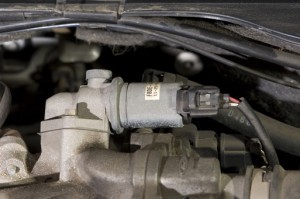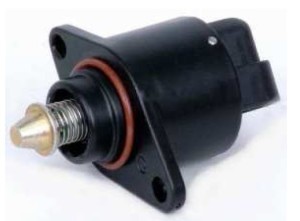What is an idle air control valve? This is a common question for those new to automobiles, especially vehicles using fuel injection systems. The Idle Air Control Valve (IACV) is a crucial component responsible for regulating the amount of air entering the engine when the vehicle is idling (foot off the gas pedal). This helps the engine maintain a stable RPM and prevents stalling. This article by Xe Tải Mỹ Đình will explain the idle air control valve in detail, its operating principle, and common types on the market.
 Ford idle air control valve, IAC valve
Ford idle air control valve, IAC valve
How the Idle Air Control Valve Works
In fuel-injected vehicles, the throttle regulates the amount of air entering the engine. Upon startup, the Engine Control Module (ECM) or Powertrain Control Module (PCM) analyzes parameters such as coolant temperature, air temperature, and atmospheric pressure to determine the amount of air and fuel needed for the starting process.
When idling, the throttle is completely closed. At this point, the idle air control valve opens a narrow passage to supply the necessary air for the engine to maintain operation, preventing the car from stalling. The amount of air passing through the idle air control valve is adjusted by the ECM/PCM based on engine operating parameters.
Types of Idle Air Control Valves
There are many types of idle air control valves, but the following two are the most common:
1. Rotary Solenoid Idle Air Control Valve
This type of valve uses an electromagnetic coil to rotate a shaft, adjusting the opening of the valve and the amount of air passing through. The PCM sends a signal to adjust the current flowing through the coil, thereby controlling the position of the shaft and the amount of air bypassing the throttle. When the current is high, the valve opens more; when the current is low, the valve opens less. The advantage of this type of valve is its high durability and stable operation.
 Generic idle air control valve
Generic idle air control valve
2. Stepper Motor Idle Air Control Valve
The stepper motor idle air control valve uses a stepper motor to precisely control the opening of the valve. The stepper motor can move the valve in small steps, allowing for finer adjustment of the air flow. The ECM/PCM sends a signal to the stepper motor to adjust the position of the valve, ensuring the amount of air entering the engine is always at an optimal level.
Role of the Idle Air Control Valve During Deceleration
The idle air control valve not only operates when the vehicle is idling, but also participates in the deceleration process. When you lift your foot off the accelerator pedal, the ECM/PCM will stop fuel injection to reduce the engine RPM. However, the engine still needs some air to maintain operation. At this point, the idle air control valve will open to provide air, helping the engine decelerate smoothly and preventing stalling.
Cleaning and Maintaining the Idle Air Control Valve
The idle air control valve can become dirty due to carbon deposits or oil, affecting engine operation. Common symptoms include difficulty starting the car, unstable engine RPM, or stalling. Cleaning the idle air control valve regularly is very important to ensure stable engine operation. You can use a specialized throttle body cleaner to clean the valve.
Conclusion
The idle air control valve is an important component in the vehicle’s fuel system, helping the engine operate stably at idle and during deceleration. Understanding the operating principle and how to maintain the idle air control valve will help you maintain the performance of your vehicle and extend the life of the engine. If you encounter any problems with the idle air control valve, please contact Xe Tải Mỹ Đình for advice and support. We specialize in providing professional and reputable truck repair and maintenance services.